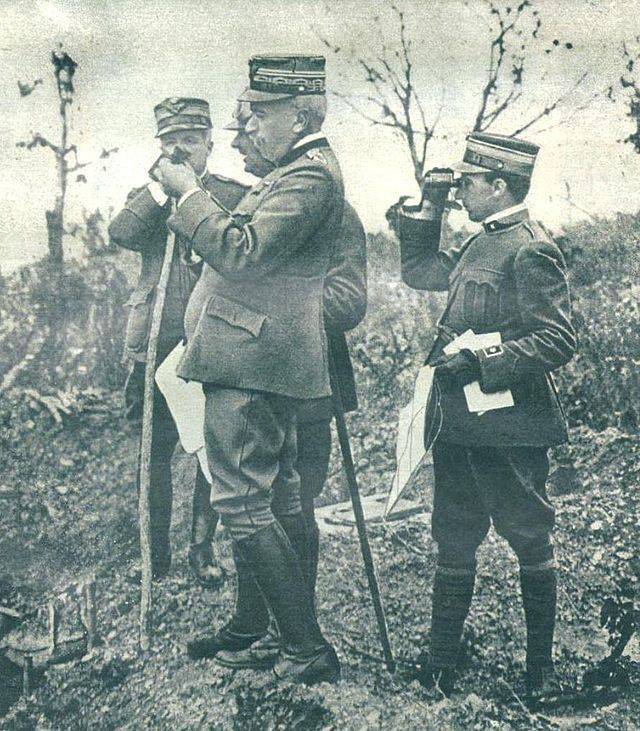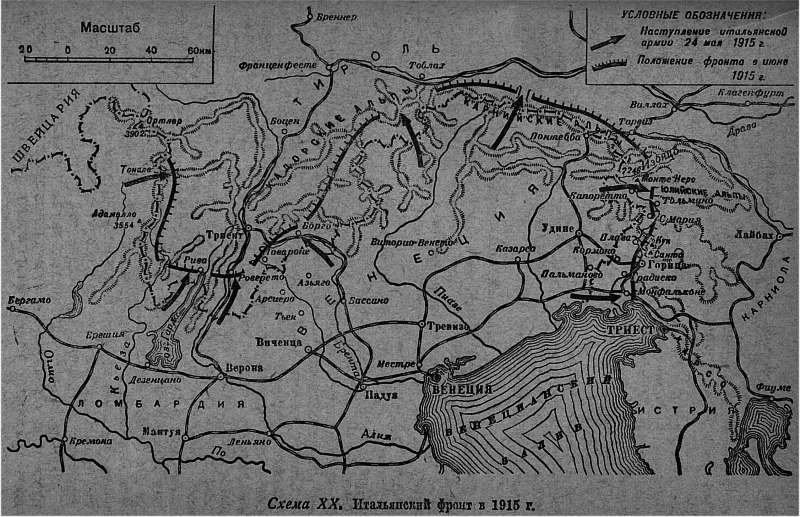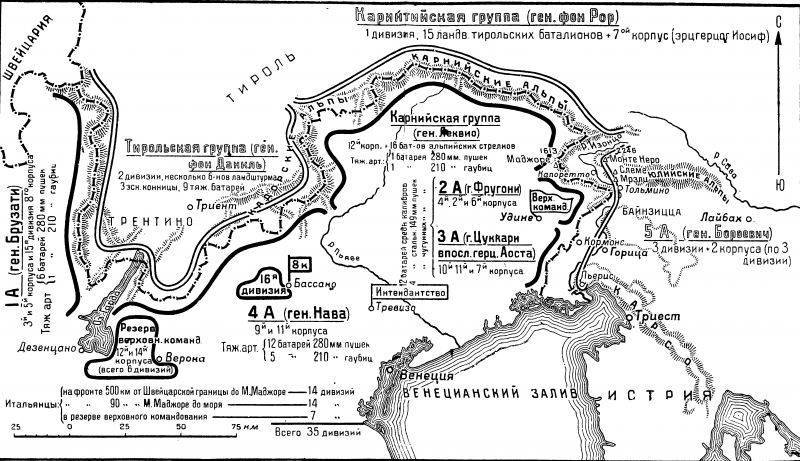Battle of the Isonzo
23 May 1915, Italy entered the war, declaring war on the Austro-Hungarian Empire. At the same time, the Italians declared war only on the Habsburgs. With the German Empire, Italy broke off only 27 August 1916’s diplomatic relations. This was beneficial to Berlin, as it allowed to maintain the hope that through Italy it would be possible to maintain contacts with other countries and receive the necessary goods. True, this did not prevent the German troops from participating in operations in the Italian theater of military operations.
The Austro-Italian border ran along difficult terrain for conducting combat operations — the Alps ridge (Julian, Cadorian, and Carnic Alps). In this case, the Austrian possession went into a wedge south in the region of Trentino. This made it possible for the Austro-Hungarian troops to organize a quick invasion of Lombardy and the Venetian region by the valleys of the Brenta, Adiz and Chiesa rivers. In addition, the most important part of the Italian front was the valley of the Isonzo River, which separated Italy from Trieste and Istria, and from where it led the shortest route to Serbia.
Mountain conditions dictated the conditions of warfare. Many positions were practically impregnable in terms of the development of technology of the time. Bypassing the enemy and attacking his flanks was an extremely difficult task. In the area of Trentino, the troops had to be supplied by means of funiculars and cableways. For the conduct of hostilities, divisions of rock-climbers and assault squads were created, which had special training and ammunition for action in mountain conditions. From the very beginning, the opponents had to wage not a maneuverable war, but a war of attrition, breaking through the strongly fortified positions of the enemy.
It should be noted that the Italian army was poorly prepared for war. Although during 1906-1914. some improvements were made, the whole picture was unsightly. A huge number of young people of draft age were exempted from service, so-called. the third category, exempt from compulsory service, was to undergo brief military training, but it was not organized. There were not enough officers and non-commissioned officers, the training of reserve officers was neglected. The reserve officers were people with higher education who carried out regular service, after the exam were transferred to the officer rank, served as officers of 3 for months, then returned to civilian status. The field artillery was in the process of reorganization and was still partially armed with the guns of the old systems. Heavy and medium guns was not enough, and ammunition is not enough. In the infantry regiments there were only one machine-gun platoon. The air fleet and motorized transport were in their infancy, there wasn’t even enough horse-drawn transport. The organization of supply was unsatisfactory. Bad deal with the morale of the army. After the start of the war, the Italians made significant efforts to remedy the situation, reorganize the army, re-equip artillery, replenish warehouses, but on the whole, the Italian army was in poor condition.
Party plans
Italy. The political interests of Rome were concentrated mainly on the right flank of the front, in the valley of the Isonzo, from where the road opened to Trieste, Istria, and further to the Balkans (Dalmatian coast and Albania). On the other hand, the Italians understood that from the direction of Trentino the Austrians could go on a dangerous offensive.
Thus, for the Italians both fronts of the front were of great importance. On the right flank they decided to focus the main efforts of the Italian army, developing a strategic offensive. Here formed the main shock group. On the left flank it was necessary to put up strong barriers, insuring the main communications of the Italian army. On the left flank were going to lead an active defense. They also planned to conduct a private operation in South Tyrol to capture the Trentino area. At the same time, in the region of Trentino, the Italians created a strong defense, since the enemy’s breakthrough threatened the communications of the army, a rich Venetian region and important industrial centers.
The Italians hoped that the Austro-Hungarian army was distracted by the fighting on the Russian front, and this would allow the Italian army to occupy all the key passes in the mountains and the dominant border points, thereby depriving the enemy of the possibility of conducting a serious offensive operation. At the second stage, the operations planned to develop an offensive deep into enemy territory. The Italians saw that the Austrians beat both the Russians and the Serbs, and found the enemy weak, easy and win-win.

Commander of the Italian Army Luigi Cadorna
Austria-Hungary. During the 1914 campaign, the Austro-Italian border was occupied by weak units of the Austro-Hungarian army (in fact, the militia barriers). However, as the negotiations were delayed, and things were moving towards the transfer of Rome to the side of the Entente, the positions were strengthened. As a result, in May 1915, the border was not defenseless. Austro-German command easily revealed the direction of the main attack of the Italian army, realizing that the main target of the attack of Italy would be the valley of the r. Isonzo. Therefore, for many months defensive positions were being prepared on the Isonzo. Germany and Austria-Hungary focused their attention on the Eastern Front during the 1915 campaign, so on the Italian front the Austro-Hungarian command decided to keep the defense. The border was covered on the most important directions and focused on the construction of fortifications. In the areas of Tolmino and Goritsy strong bridgeheads were built. The mountainous region of Trentino was generally turned into an impregnable bastion. Each mountain and the dominant height were protected by fortifications, bristling with guns. Extensive communications were prepared, which are extensions of the iron roads from the depths of the Austro-Hungarian Empire.
From the very beginning of the war, the Austro-Hungarian high command worked out the issue of the defense of the south-western borders. General von Rohr did a great job. At the beginning of his troops was a little and of poor quality - landver battalions, marching replenishment, volunteers and working units. However, he put them in order and did a great job on the construction of fortifications. Natural caves were adapted for military purposes, hundreds of caves were cut down in the rocks (only in Trentino there were about 300). The Austrians dug and hollowed out tens of kilometers of trenches, covered them with wire barriers, built blockhouses (fortification fire structures adapted for all-round fire and the garrison's residence). To supply the troops, new soil and railways were built. In general, the Austrian troops did everything to prepare a complete and coherent defense system. The defense system of the Austrian army was very good, since the Austrians could work without interference from the enemy and took into account the experience of the ongoing heavy battles in other directions. At the same time, the breakthrough of the Austrian defense in the region of Trentino was not critical for Austria, since others, also passing through mountainous areas, dragged behind the first line of defense. Nearby there were no vital centers for Austria-Hungary.
At Izonzo, the fortification works slowed down somewhat, as the Austro-Hungarian command did not immediately decide where to put up real resistance. It was believed that the Italians should be lured to Laibach, where they would prepare a trap and attack from the flanks and to the rear. In the valleys of Sava and Drava, it was intended to concentrate the 3 of the Austrian corps, reinforced by the German divisions of the 10. However, this plan had to be abandoned, since the Chief of the General Staff of Germany Falkenhayn refused to provide German troops. He was skeptical about the plan of the operation and did not want to distract large German forces from other areas for an indefinite period. In addition, while Italy did not declare war on Germany, they wanted to use it as a transit country. It was hoped that it would be possible to agree with Italy on the continuation of trade. Although this hope in the end did not materialize.
Therefore, the chief of the general staff of the Austro-Hungarian troops, Konrad von Hoettsendorf, had to change the original plans and on April 21 on the 1915 of the year, issue an order for reinforced fortification works on the Isonzo. By the end of the month, defensive work was mostly completed. The line of defense was significantly strengthened. By mid-May, the Austrian command of this area reported on the performance of work. At the same time, work was carried out in very difficult conditions on the Alpine site and the Carso Plateau (south of Gorica). The work was carried out at a high altitude, often among the ice and snow, among the bottomless abysses and gorges, where one careless step could destroy a person. The tops of the mountains and the dominant heights by nature were prepared for defense, one machine-gun calculation could hold considerable forces. The Carso Plateau was practically lifeless, a real desert with sharp rocks. Here even the water was delivered in barrels.
Thus, the Austro-Hungarian command decided to act on defense. Austrian territories decided not to give up. For tactical reasons, only the plain to the west of the Isonzo River and some of the positions in the southernmost part of the Trentino region were cleared in advance. At the same time, a powerful and deeply echeloned defense of the mountainous region of Trentino and the Isonzo was organized, especially at the bridgeheads of Tolmino and Goritsy.
The forces of the parties
Italy. The mobilized Italian army consisted of 12 corps and a significant number of police divisions. The strength of the Italian army at full exertion reached 2 million, of whom about half of them immediately called for banners, the rest remained in reserve, and were called in as needed. One of the main weaknesses of the Italian army was a big flaw in heavy artillery.
The 1-I Italian army under the command of General Bruzati consisted of the 3-th and 5-corps, the 15-th division of the 8-corps. This army turned from the border of Switzerland to Lake Garda. The 4 Army under the command of General Naw consisted of the 9 and 1 corps. The troops of the 4 Army turned around from the lake. Garda, through the Cadorian Alps to the upper reaches of the river Piave. General Lekvio's Carnian group consisted of the 12 corps and the 16 battalions of alpine riflemen. The Karni group stretched along the crest of the Carnian Alps.
The 2 army of General Frugoni had 4, 2 and 6 corps. Frugoni troops stationed in the Julian Alps from Monte Maggiore to the road Cormons - Gorica. The 3 Army of General Zuccari (later replaced by the Duke of Aosta) had the 10, 11, and 7 corps. This army occupied the rest of the Julian front down to the sea. The 2-I and 3-I armies must cross the border, reach the Isonzo River, capture the ferries through it. The left flank of the main strike force (the I-th army) was to take Caporetto, force the Isonzo, occupy the mountain range of Monte Nero, Slémé, Mrzli. The right flank of the strike force (3-I army) received the task of taking the ferry from Pieris. It was believed that the capture of the Bainzitz plateau would automatically lead to the abandonment of the Goryza fortification by the Austrians and positions on the Carso plateau. Further, it was possible to develop an advance to the east and southeast.
In addition, at the disposal of the Italian High Command had a reserve. It consisted of two corps - the 12 and 14 (six divisions), located between Desenzano and Verona, and the headquarters of the 8 corps with the 16 division in Bassano. The high command reserve was supposed to reinforce the strategic defenses in the Trentino area. It was planned that after the Italian troops secure a more advantageous position in the area of Tretin, the reserve would be directed to the Julian direction.
Thus, at the beginning of the war, the Italians deployed 35 divisions. Of these, the 14 divisions were deployed on the 500-kilometer front from Switzerland to Maggiore, the 14 divisions were concentrated on the 90-kilometer stretch of the Julian direction, and the 7 was in high command reserve. High Command was located on the Julian front in Oudinot, commissariat - in Treviso. The nominal commander in chief of the Italian army was King Victor Emmanuel III. In fact, the monarch never commanded and intervened in the management of operations and in the orders of the High Command. In fact, the troops were led by the head of the Italian General Staff, Count Luigi Cadorna. Subsequently, Cadorna's actions were heavily criticized. However, it is obvious that at that time he was a good general and a first-class organizer who, from July 1914 of the year to May 1915, actually created a new army. The main shortcoming of Kadorna was the inability to maintain constant communication with the generals and understand the psychology of the soldiers.
Austria-Hungary
Vienna, having received news of the decision of Rome to join the war on the side of the Entente, concentrated all free troops in the region of Trentino and on the Julian front. At the beginning of the war, Vienna had 12 divisions on the border with Italy. The inaction of Serbia allowed the Austrian command to reduce the number of its troops on the Sava River and the lower Danube up to 48 thousand people and use almost all the troops from the Serb front against Italy. 5 divisions were redeployed from Serbia, and 2 divisions from Galicia. Germany supported the Alpine Corps (1 division) and heavy artillery. However, these additional forces were concentrated on the Italian front only during the course of the battle.
By the beginning of the war with Italy, the Austro-Hungarian forces were distributed as follows. The Tyrolean group under the command of General von Dunkl defended the Trentino area. It consisted of 2 divisions, several militia battalions, 3 cavalry squadrons and 9 heavy batteries (not counting divisional artillery). Under the command of General von Rohr, the Carinthian group occupied positions in the Carnic Alps. It consisted of one division, the 15 of the Landguard Tyrolean battalions. A few days after the declaration of war, the Carinthian group was reinforced with the 7 Corps under the command of Archduke Joseph. The 5 Army under the command of General Boroevich was defending at Isonzo. It consisted of three divisions, plus two army corps (three divisions in each), which were transferred from the Balkan front. In addition, Germany, although not officially at war with Italy, sent the Bavarian Alpine Corps to help in Tyrol (in fact, one reinforced division).
Thus, the Austro-Hungarian command decided to defend on previously prepared and fortified positions. The Austro-Hungarian Empire entered the war on the Italian front with the 12 divisions, taking into account the troops of the three Austrian corps (6, 15 and 16), which were still on the way, the number of Austro-Hungarian troops increased to 20 divisions. Then the number of Austro-Hungarian troops increased to 25 divisions (234 infantry battalion, 21 cavalry squadron and 155 batteries). The main forces of the Austro-Hungarian army (20 divisions) acted on the Julian direction (Isonzo). The Austro-Hungarian army was inferior to the Italians in number, but had an advantage in artillery, especially heavy, machine guns and modern combat means. In addition, the Austrians had the opportunity to prepare a strong defense, making good use of the time available before the start of the war and the advantageous positions.
To be continued ...


Information